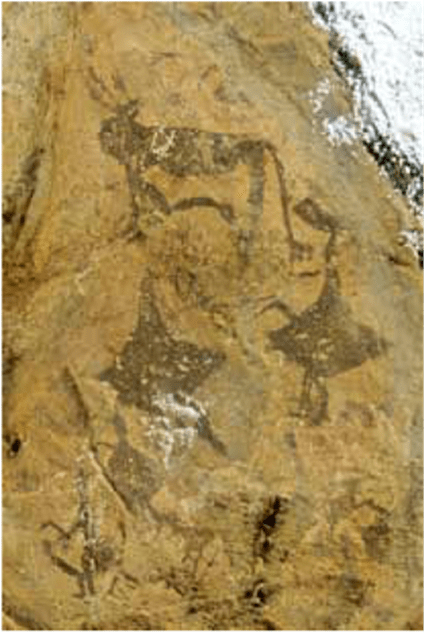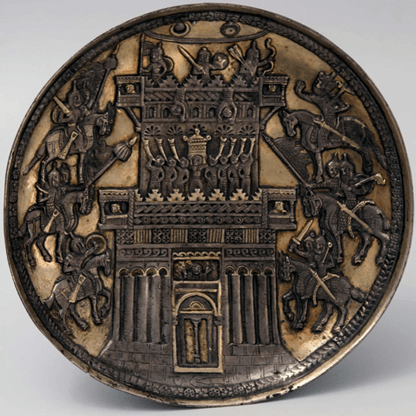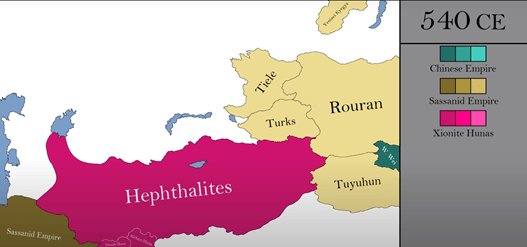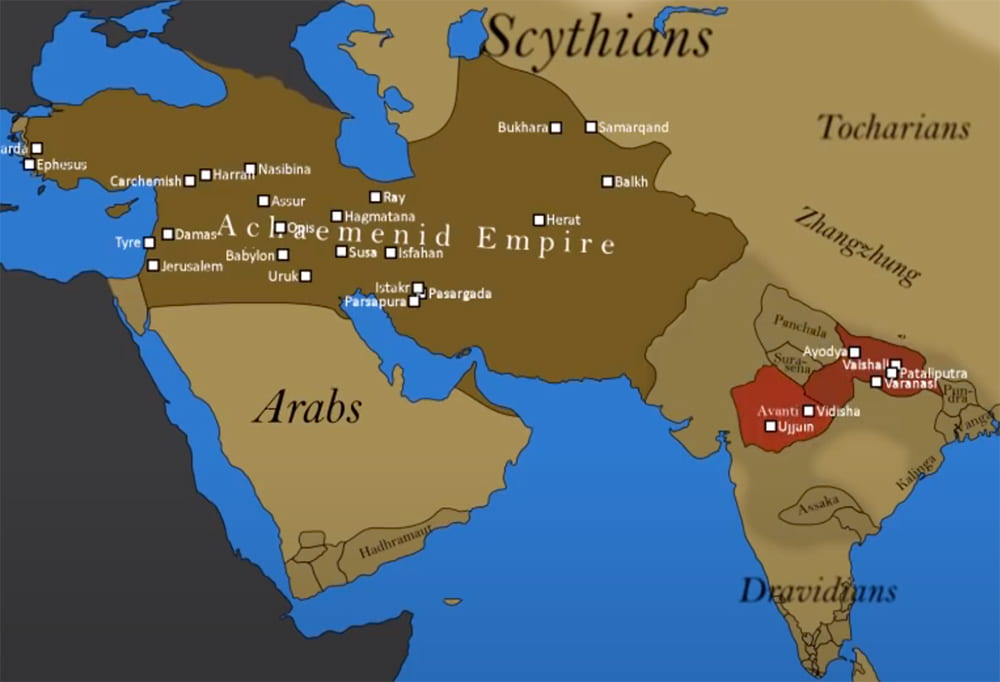The region that houses Uzbekistan today, usually referred to as Central Asia or Central Eurasia, has a deep history of complex agricultural societies stretching back to around 2600 BCE. Mobile pastoralism developed in a variety of locations across Central Eurasia at about this same time.
 Mesolithic rock art depicting a bull and people (Photo by Andrzej Rozwadowski)
Mesolithic rock art depicting a bull and people (Photo by Andrzej Rozwadowski)
Starting shortly after the development of urban societies, the land that is today Uzbekistan was connected to China, the Middle East and Europe by the Silk Roads (follow this link for a visual tour of the “Silk Road” today). Although the Silk Roads are famous for their trade in luxury goods, these shifting trade routes also facilitated cultural exchange dating back thousands of years with present day relevance. Find Sogdia on this map! That is about where Uzbekistan is today.
 Silk Road ca. 1st century CE (wikicommons)
Silk Road ca. 1st century CE (wikicommons)
For a quick overview of Central Asian political history up until the Mongol Empire, watch this video: https://www.youtube.com/watch?v=VwuFavM9jWY.
If your students found the timeline video helpful, try using this video too and focus their attention on the Oxus people, the Andronovo, the Tokharians, the Scythians, the Achaemenid Empire, the Kushans, the movements of peoples and tribal confederations from east to west across Eurasia: https://www.youtube.com/watch?v=3S734SZ4bcc.
Understanding world religions is an important part of Global Geography. Learning about the ancient history of Central Asia gives us an opportunity to learn about seven different religions and how different belief systems interacted and co-existed in ancient times.
Zoroastrianism
The first religion we will learn about is Zoroastrianism. This ancient religion was established by followers of the prophet Zoroaster. The prophet Zoroaster is believed to have lived as early as the thirteenth century BCE in Central Asia. The religion he founded is still practiced today in Iran and India. The sacred book of the Zoroastrians is called the Avesta and it preserves a number of hymns that are attributed to Zoroaster himself, called the Gathas, written in an old Iranian language. It is likely that these hymns were transmitted orally for several centuries before being recorded as the Avesta in the early centuries CE. Zoroaster’s teachings can be thought of as one of the earliest forms of monotheism because he singled out one god, Ahura Mazda, “the All-Knowing Lord,” from among the other ancient Iranian gods, whom he called daēvas (an early ancestor of the English world “devil”). Bull sacrifices were also common among early Zoroastrians; therefore, it is not surprising that we should see the bull at the center of the ritual shown in the rock art above. The bull was a symbol for the Moon in Zoroastrian cosmology. The Sun was even more sacred. Many early Zoroastrians believed that the sun was a visible form of Ahura Mazda and that fire was a symbol of Ahura Mazda’s presence on earth. This meant that fire had the power to purify unclean spirits.
Over a thousand years after Zoroaster’s life, Zoroastrianism was codified as a state religion by the Sasanian dynasty in Iran, during the third through seventh centuries CE. However, Zoroastrianism was practiced somewhat differently by the Sogdians and other groups in ancient Central Asia. Although much of what we know about Zoroastrianism today was codified by the Sasanians, it is likely that the religion that the Sogdians and other Central Asian peoples practiced was a slightly broader version of old Iranian religion, which included the worship of the god Ahura Mazda, and at times included worship of the Greek goddess Demeter and the Hindu god Shiva. The most important legacy of Zoroastrianism in Uzbekistan today is the Navro’z celebration, a New Year’s celebration held each year at the spring equinox.
 Photos of a modern Navro’z celebration
Photos of a modern Navro’z celebration
Judaism
Judaism first arrived in Central Asia with the Judeans who were freed by the Persian ruler Cyrus the Great, who conquered Babylon in 539 BCE. At that time, they became citizens of the Achaemenid empire.
The Achaemenid empire around 400 BCE
Although the sources aren’t perfectly clear, it is quite likely that Babylonian Jewish populations made their way to Bactria and Sogdiana, two regions that Cyrus had conquered a few years before his conquest of Babylon. They eventually become involved in the trans-regional silk trade with China. Pottery with Hebrew names on it dates to the first through third century CE and an early Judeo-Persian document from Khotan dates to the 8th century CE. It is from these groups that the modern Jewish communities in Bukhara and Samarkand trace their descent.
Buddhism
Siddhartha Guatama, later referred to as the Buddha, which means “the Enlightened One,” was born in around 563 BCE near the Ganges river in India. As a reformer, he sought to find a middle path between worldliness and the asceticism of the Jainists, who followed another ancient Indian religion that required a very strict adherence to nonviolence against other souls. Legend has it that, after becoming dissatisfied with how the various religions of his day could not explain the suffering he saw in the world, he sat underneath a tree for forty-nine days in meditation. He emerged from this meditation as the Enlightened One, the Buddha, and began to teach the Four Noble Truths: that all life involves suffering; desire is the cause of suffering; the elimination of desire brings about the elimination of suffering; living a disciplined life in line with the Noble Eightfold Path brings about the elimination of desire. The Noble Eightfold Path consists of right belief, right resolve, right speech, right behavior, right occupation, right effort, right contemplation, and right meditation. Over the next twenty-five centuries, his teachings would be interpreted in a number of different ways in numerous theological schools and spread across Eurasia. In the centuries before the common era, Buddhism took hold in what is today southern Uzbekistan and Afghanistan, known at the time as Bactria. Inscriptions made by the great Indian king Ashoka (who ruled 268-232 BCE) indicate that he sent missionaries into his northwestern territories [Foltz, page 43 note 15]. The Sogdian traders, versed in a number of languages and writing systems, spread this religion as far as China, by the early centuries CE. The Kushan dynasty, especially under the reign of Kanishka II during the second century CE, is famous for its patronage of Buddhism, however their coins also depict Iranian, Indian, and Greek gods as well. During the Kushan period, the monk Sutralanka traveled to what is today Tashkent, Uzbekistan, in order to decorate a Buddhist monastery there. The seventh century Chinese Buddhist pilgrim Xuanzang records that there were one hundred Buddhist temples and three thousand priests in Bactria. These temples were financed by silk road traders.
In the medieval period, the Khitan Qarakhitai dynasty, who ruled Mā warā’ an-nahr from 1141 to 1220, were Buddhists. This group had ruled diverse populations in North China for two centuries before invading Central Asia, which is why it is not too surprising that the Qarakhitai period is known for an increase in Christian activities as well as key developments in Islamic jurisprudence [Biran 2005: 171-194].
Buddhist stupa in Fayaz-Tepa, Termez (Surkhondaryo Region, southern Uzbekistan)
Christianity (The Church of the East)
Sometimes referred to as “Nestorian Christianity,” after the Syrian bishop Nestorius who had been the Patriarch of Constantinople in 428 and taught that Christ had been two distinct persons (one of them human and one of them divine), the Church of the East was established in Iran as early as the 4th century CE. Similar to Judaism, Christianity spread from Iran to Central Asia through the trade networks of the Sogdian merchants, and lasted in Central Asia until at least the mid-fourteenth century, when the Christian population was wiped out by the Black Death. The Sogdian traders were enthusiastic converts to Christianity, perhaps due to its positive emphasis on trade. An early eastern Christian hymn, written in Syriac, an old Middle Eastern language, emphasizes the community’s commercial focus: “travel well-girt like merchants, that we may gain the world” [Foltz page 60, citing Lieu 1992]. By 650, there were archbishoprics in Samarkand in the middle of Sogdiana, as well as in Kashgar, further to the east [Foltz 65; citing Mingana 1925]. Similar to Buddhism and Manichaeism, the Sogdian traders were crucial in spreading eastern Christianity across Central Asia through their merchant networks and many of the surviving Christian books from Central Asia are written in Sogdian. Follow this link for a brief discussion of how the flying camel motif helped us understand the spread of the Church of the East.
 A ninth century Sogdian Christian scene taken from the book of Joshua
A ninth century Sogdian Christian scene taken from the book of Joshua
Manichaeism
Manichaeism is less well known than Christianity today, but in antiquity it played a significant role in Sogdian history. Manichaeism is what we call the religion that was founded by the prophet Mani, a man of Parthian ancestry, who was born in 216 in what is today Iraq. Texts preserved on Greek papyrus show that Mani grew up in a diverse religious environment including Jewish, Christian, and gnostic teachings. He received his first revelation at the age of twelve and then a second revelation at twenty-four. After this second revelation, he took up prophethood and journeyed eastwards to what is today Pakistan, where he learned the teachings of Buddhism. On returning to Iran, he challenged the Zoroastrians for religious and political power at the Sasanian court. Under the patronage of Shapur the Great (ruled 241-271), Mani was able to spread his new religion. However, when the next ruler came to power, Bahram the First (ruled 271-274), Mani lost favor and died in prison at the age of sixty. Mani’s religion included a four-part division of society between male and female priests, called the “Elects,” and male and female normal people, who were called the “Hearers.” Similar to Zoroastrianism, Manichaeism divides the world into either “good” spirits embodied by light or “evil” matter, from which light can be liberated. Mani presented himself as the fourth prophet in a series of prophets stretching back to Zoroaster, the Buddha, and Jesus. For Manichaeans, Jesus was the most important of the three and Mani thought of himself as “the Apostle of Jesus Christ.” Mani believed that Jesus took three forms: as the historical man who died on the cross, which Mani believed to have been an illusion; as a living soul called the “suffering Jesus,” who was the force of goodness embodied by the light particles that are trapped in all living things; and as Jesus “the Splendor,” who was the embodiment of Light and visited the First Man and will return as the Savior at the end of time [Foltz page 73]. Because Mani believed that the light decreases with each generation, Manichaean priests were not allowed to have children. They were further distinguished from the rest of society with white clothing and a vegetarian diet.
 Manichaean priests from an 8th/9th century manuscript (US public domain)
Manichaean priests from an 8th/9th century manuscript (US public domain)
Some sources say that the Elects were not even allowed to prepare their own food, because it was believed that touching vegetables could damage the light particles residing in all living things. Mani was also a great painter and he illustrated his own scriptures, when he put his revelations down in writing. If Manichean religious doctrine sounds confusing, don’t worry! Manichaeans often communicated their ideas using the symbols of the communities to whom they were preaching, so numerous other symbols were incorporated into this religion over the years. (Some scholars even think that Mani’s use of Christian symbolism was intended to win over Christian mystics and wasn’t really part of his original religion.) After the establishment of the new faith in the third and fourth centuries CE, it was repressed by the Christians in the Mediterranean region and eventually by the Zoroastrians in Persia, starting during the reign of Bahram the First. Luckily by that time, Manichaeism had already won many converts among the Sogdians of Central Asia. The Sogdians used their language skills to translate Manichaean texts from Syriac, Middle Persian (the language of the Sasanian dynasty) and Parthian into Sogdian, Turkic and Chinese. It was the Sogdians who spread Manichaeism to the Uyghur Turkic empire that ruled Mongolia in 763-840. The Uyghurs made it their state religion and attempted to ban the Turkic shamanism (see below for more on shamanism) that had preceded it. Ibn Nadim, a tenth century Islamic historian, relates a story about how the Uyghur khan in the ninth century threatened the governor of Khurasan (who was also responsible for Mā warā’ an-nahr or Transoxania as well) that if he harmed the five hundred Manichaeans living in Samarkand he would slaughter the Muslims living in the Uyghur khanate [Foltz, page 79, Ibn Nadim, page 803]. If true, this story suggests that there were already significant Muslim populations living to the northeast of the Tian Shan mountains in the 9th century and the Uyghur khaghans had the ability to influence people outside of their territory. This also seems likely, because of how the Uyghurs used their political influence over the Tang dynasty to protect Manichaeans in China. Although Manichaeism was the official religion of the Uyghur empire, Buddhism, Christianity and “the traditional Turkic shamanistic religion” remained common among their subjects.
The spread of Manichaeism from Dorling Kindersly’s World History Atlas. (No alterations made). The shaded area shows the core regions of Manichaeism.
Shamanism
Shamanism is Central Asia’s oldest religion. Although it is hard to put on a historical map, it is likely older than Zoroastrianism. It is the most similar of Central Asian religions to the religions of the indigenous people of North America. Followers of this religion believe that plants, animals, rocks and other living things possess a spiritual essence. Shamans, or qams as the Old Türks would have called them, are believed to be able to influence nature through words and gestures. (Qam is the Old Türk word for “shaman” [Nadelyaev et al., page 413]). Shamans are also understood to be the mediator between people and the unseen world. Old Turkic inscriptions, in what is today Mongolia, indicate a belief in a sky god called Tangri as well as the earth god. An early Turkic source, the Irk Bitig, translated as “The Book of Omens,” gives us a look at the understanding of shamanistic and syncretistic religion as written in runic Turkic in the 8th or 9th centuries. Although the majority of Turkic Shamanism was passed down through oral tradition, this book tells us how one writer decided to record part of this religion. This book describes in detail how to interpret over fifty different omens, including omens regarding eagles, falcons, leopards, different colors of horses, ravens, the behavior of camels, tigers, and if an ox gets eaten by ants, as well as how to interpret the weather. The influences of Manichaean and Chinese titles in this text suggest that this religion existed in a diverse syncretistic context. (Syncretism is when two religions are believed in at the same time by the same person or the same group of people, often creating a third religion).
Among scholars of religion and culture, the use of the term “shamanism” is still controversial, and it is sometimes used negatively for simplifying complex local belief systems. What is important about shamanism for Central Asian history is that many of the Turkic peoples believed that the Nestorian Christian priests in the seventh and eight centuries and the Sufi Islamic missionaries in the 10th through 12th centuries were actually qams. For this reason, much of the conversions of early Turkic peoples to major world religions can be seen as a form of syncretism. This type of syncretism was also common during the Mongol period.
 A wall painting from Afrosiyob, modern Samarqand, depicting the Western Türk dynasty court. The Western Türks (as you would write it in old Türk:
A wall painting from Afrosiyob, modern Samarqand, depicting the Western Türk dynasty court. The Western Türks (as you would write it in old Türk:
On oq budun, ruled roughly 603-657 CE) incorporated shamanist practices into their state rituals.
Islam
On the eve of the Arab conquest, Sogdiana was ruled by the Hephthalites in the East and the Afrighid Khwarazmshahs in the West. At this time, all of the religions that we learned about above, Zoroastrianism, Buddhism, Manichaeism, Eastern Christianity and Shamanism, were prevalent among the local people. It is hard to say which was dominant and it is possible that people picked and chose between them.
 Hephthalites between Sasanian and Rouran empires
Hephthalites between Sasanian and Rouran empires
Trade was a major factor in the spread of each one of these religions and when Islam arrived in the 7th century CE in Central Asia, it also expanded through trade. In 610 CE, the prophet Muhammad began hearing the word of God, in the form of revelations in Arabic. Supported by his wife Khadija, who was from a rich merchant family, Muhammad realized that the revelations he was receiving were from God and they were calling on him and his society to mend their ways. Muhammad lived in a town called Mecca, which is in Saudi Arabia today. In the 7th century, Mecca was a key trade center, and the elite of Mecca were very wealthy. Many of Muhammad’s revelations addressed social injustice and, for this reason, a number of his early followers were the poor and dispossessed of Meccan society. In 622, the citizens of an agricultural oasis to the north of Mecca, called Yathrib at the time, heard of Muhammad’s message and invited him to serve as an arbitrator in some of their disputes. Muhammad agreed and immigrated to Yathrib along with his followers in an event called the hijra, which begins the Islamic calendar. This calendar is still used today in some countries and was used in Central Asia up until the 20th century of the Christian calendar. After Muhammad’s death in 632, Islam spread across the Middle East, reaching North Africa by the 650s, and Northern India by the 660s. After the prophet’s death, the Muslim community was led by a person called a Caliph, from the Arabic world khalīfa, meaning “the successor.”
The Expansion of the Caliphate
 The Arabs first entered what would become Uzbekistan when they crossed the Oxus river in 653-4, during the reign of the Caliph CUthmān (644-56). At this time, the city of Bukhara was ruled by a woman named Khātūn, who was ruling for her son Tughshāda. She seems to have been a generous ruler and a skillful politician. One story relates that, when she needed to show her loyalty to the Arab general Sa’īd, she gave him eighty princes and landowners, who had been disloyal to her and her family, as hostages. Other accounts emphasize how she used Bukhara’s wealth to remain in power and one of her shoes is believed to have been worth 200,000 dirhams (silver coins weighing about three grams [Narshakhi pages 37-39]). The First Fitna (656-661 CE, a civil war between the Arabs) slowed the Arabs’ consolidation of power in Central Asia and it was not until 706 that the Umayyad general and governor of Khurasan Qutayba b. Muslim al-Bāhili conquered Bukhara and Paykand and began building the first mosques. However, after Qutayba’s death in 715, the Türgesh (a Turkic tribal confederation) allied with the Sogdians and took back part of what Qutayba had conquered.
The Arabs first entered what would become Uzbekistan when they crossed the Oxus river in 653-4, during the reign of the Caliph CUthmān (644-56). At this time, the city of Bukhara was ruled by a woman named Khātūn, who was ruling for her son Tughshāda. She seems to have been a generous ruler and a skillful politician. One story relates that, when she needed to show her loyalty to the Arab general Sa’īd, she gave him eighty princes and landowners, who had been disloyal to her and her family, as hostages. Other accounts emphasize how she used Bukhara’s wealth to remain in power and one of her shoes is believed to have been worth 200,000 dirhams (silver coins weighing about three grams [Narshakhi pages 37-39]). The First Fitna (656-661 CE, a civil war between the Arabs) slowed the Arabs’ consolidation of power in Central Asia and it was not until 706 that the Umayyad general and governor of Khurasan Qutayba b. Muslim al-Bāhili conquered Bukhara and Paykand and began building the first mosques. However, after Qutayba’s death in 715, the Türgesh (a Turkic tribal confederation) allied with the Sogdians and took back part of what Qutayba had conquered.
During the chaos of the Abbasid revolution (749-50), the Tang dynasty general of the Western Regions Gao Xianzhi (Go Seonji), who was originally of Korean (Goguryeo) descent, expanded his territory first into the Pamirs and then into eastern Mā warā’ an-nahr to form an alliance with the local rulers of Ferghana. At this time the local rulers of Chach (a region around modern Tashkent, the capital of Uzbekistan today) called in reinforcements from the famous Abbasid commander Abū Muslim. An Arab army was sent to Mā warā’ an-nahr and in 751 they did battle with a Chinese army of 30,000 men at the city of Talas (today Taraz in southern Kazakhstan). When the Qarluq Turkic confederation also attacked the Chinese from the northeast, the Chinese army was defeated and only Gao Xianzhi and his bodyguards escaped, leaving behind silk-weavers and paper-makers. An important connection with the stories of Ibn Sina and Al-Biruni in Part Two is that the paper-makers set up shop in Samarkand and proceeded to supply the Muslim world with paper, which would help facilitate an intellectual revolution a few centuries later.






